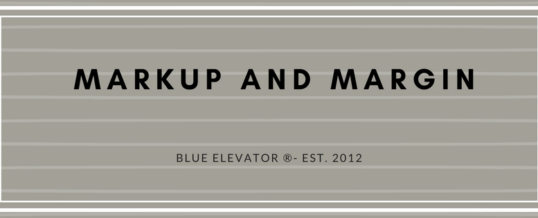
Markup and Margin
I want to introduce you to my two friends – markup and margin.
What do you think when you hear the term markup? What about margin?
Are they one in the same? Or, are they different?
In this article, we’ll explore these two kissing cousins. And, we’ll reveal a big secret.
Pricing Example
God willing, we’ll just hit this head on. Let’s say that you are the leading producer of Gizmos.
- It costs you $100 to make a Gizmo.
- And, your business advisor recommends that you try to achieve a 50% margin.
- What is your price?
Markup
Well, here’s what most people do:
- They take their Direct Costs of $100.
- Next, they do a 50% markup.
- Here’s the math: $100 Direct Costs + %50 (of $100) = $100 + $50 = $150.
- So, $150 becomes the Sales Price.
The Million Dollar (or more) Question
How much did you make?
And, what is the Gross Margin?
- Your Direct Costs are $100.
- Your Sales Price is $150.
- So, you made $50. That is your Gross Margin.
Simple, right?
A Different Spin
Now, let’s take a different spin on things.
Remember, your business advisor recommended a 50% margin. And, I might guess the majority of people approach things on a markup basis. That is, using the methodology given above.
So, the million dollar question is whether you are looking for a 50% markup or a 50% margin.
Calculating Margin (Gross Margin) Percentage
Using our markup example, here’s what we know:
- Direct Costs = $100
- Sales Price = $150
- Gross Margin = $50
Now, let’s calculate the Gross Margin percentage.
- Gross Margin = $50
- Sales Price = $150
- Gross Margin percentage = 33% = $50/$150
- Huh?! What!?
NOTE: Markup and Margin aren’t necessarily the same.
Back to the Million Dollar Question
So, this question becomes important. Are you targeting a markup percentage? Or, are you targeting a gross margin percentage?
How to Calculate Sales Price Using a Gross Margin Percentage
If your real goal or target is to achieve a 50% Gross Margin percentage, calculating Sales Price is different.
- Direct Costs = $100
- Gross Margin Percentage = 50%
- Sales Price = Direct Costs $100 / (1 – 50%) = $200.
So, the formula for calculating Sales Price with a specific Gross Margin percentage target is as follows:
Sales Price = Direct Costs / (1 – Gross Margin Percentage)
Now, let’s prove it.
Proof of Gross Margin
In this scenario, here’s the result:
- Direct Costs = $100
- Sales Price = $200
- Gross Margin = $100
- Gross Margin percentage = 50% = $100 Gross Margin / $200 Sales Price
The BIG Secret
As you have learned, markup and margin aren’t necessarily one and the same.
Let’s say your sales target is to sell 1,000 Gizmos a month.
- This equates to 12,000 Gizmos per year.
- At $150 a piece, your gross sales are $1,800,000. Your Gross Margin is $600,000.
- At $200 a piece, your gross sales are $2,400,000. Your Gross Margin is $1,200,000.
And, that’s a BIG difference. A $50 price difference creates an extra $600,000 in Gross Margin. Which, is a 100% improvement! Or, another way to say it. A 33% increase in sales price (e.g., $50/$150) brings about a 100% increase in Gross Margin.
NOTE: 100% = ($1,200,000 – $600,000) / $600,000
Viola! There you have it.
Summary
At Blue Elevator®, God willing, we love helping our clients take their “business to the next level™”. And, we do that by helping them Innovate, Accelerate, and Replicate®.
If this sounds good to you, we invite you to Contact Us!
JUN

About the Author:
Ken Moll is the Principal and Founder of Blue Elevator®. With professional experience spanning four decades, Ken has a breadth of foundational business knowledge rarely found – making him part of an elite class of professionals. Ken's passion is helping clients of Blue Elevator® get their “business to the next level™.”